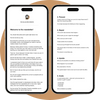
In today’s job market having creative ideas is no longer enough to propel your career.
To stand out and move up in your field, you need to become a calculated creative.
Someone who can strategically combine creativity with:
- Business understanding
- Strategic thinking
- Data analysis
All in the name of generating impactful ideas.
Being a calculated creative means grounding your creative talents within:
- Competitive landscapes
- Business objectives
- Target audiences
This enables you to produce solutions that align with strategic goals.
And create real value.
Here are 12 impactful ways you can level up your career and become a more calculated, strategic, and creative thinker:
1. Take the Time to Understand the Full Business Context
It’s essential to take the necessary time upfront to understand the business you’re operating within.
Before jumping into generating any creative ideas or solutions.
This includes:
- Business goals and KPI’s
- Target audience and customers
- Brand positioning and messaging
- Competitive landscape and differentiating factors
Immerse yourself in the full business context.
And get the foundational insights you need.
Grounding your creative thinking within business strategy and priorities from the beginning.
2. Conduct In-Depth Research into Current Industry Trends and Patterns
Another key step in elevating your creativity is conducting thorough research into:
- Current and projected industry trends
- Consumer/market research insights and data
- Identifying key patterns or problems in the marketplace
Study relevant data sources, reports, and articles.
Dig deeper into target audience wants/needs.
And identify interesting gaps, opportunities or issues.
This research will reveal insights you can use to formulate highly relevant ideas.
That work to map observable consumer insights and marketplace opportunities.
The more informed you are on industry landscape and trends…
The better you’ll be at generating creative solutions that are timely and strategic.
3. Set Clear, Specific Goals and Target Outcomes for Your Creative Ideas
Take time to clearly define 3 specific, measurable business goals.
And target outcomes that your creative ideas aim to achieve.
Rather than starting the ideation process with a blank slate.
For example, you may define goals tied to increasing sales by 15%.
Cutting campaign costs by 10%.
Improving brand awareness scores by 20 points.
When you anchor your creative thinking around tangible goals and KPIs from the start…
You can refine ideas based on how well they achieve those goals.
This goal-focused approach will produce creative that ladders up to overarching business objectives.
Instead of ideas that seem intriguing but don’t drive results.
4. Move Beyond Brainstorming and Use Strategic, Structured Ideation Techniques
When generating ideas, don’t rely solely on free-flowing, unstructured brainstorming techniques.
While brainstorming has a place, you should also use more strategic.
One focused ideation method, called SCAMPER, consists of 7 steps:
- Substitute
- Combine
- Adapt
- Modify
- Put to other uses
- Eliminate
- Reverse
This ideation processes helps you to get unstuck when facing difficult creative challenges.
Other methods include:
- Reverse Brainstorming to improve existing solutions
- Constraint-Based Ideation like the “Yes, And” approach
Using structured creative thinking tools will produce a diverse mix of strategic ideas.
Instead of going with the first few that pop into your head.
5. Prototype and Validate Ideas Early Through Real User Testing
Don’t assume your creative ideas are great.
Test them early and often.
Prototyping concepts and put them in front of real target users.
Creating basic prototypes helps to convey the essence of your ideas.
And can be things like:
- Storyboards
- Sample ads
- Functional products
Gather user feedback through methods like:
- Concept testing surveys
- Focus groups
- Usability studies
- Beta launches
Refine concepts based on learnings of what resonates with your target audience.
Validating creative assumptions will ensure your ideas hit the mark.
Before investing significant time and resources.
6. Measure Performance Data and Continuously Analyze Results to Optimize Creative
Measurement should be an integral part of your creative process.
Establish key metrics.
And rigorously track performance data such as:
- Engagement
- Conversions
- Sentiment
- Reach
Conduct regular analysis.
Drill into results.
And identify issues and opportunities.
Run experiments by iterating on creative variables.
Then, measure the impact.
Optimizing creative work based on data-driven insights will create better results over time.
Resist the tendency to rely only on assumptions.
And never use gut instinct alone when evaluating creative effectiveness.
7. Proactively Collaborate with Stakeholders Across Different Teams and Disciplines
Siloes are creativity killers.
Ensure you’re collaborating with stakeholders from different teams.
Including:
- Sales
- Marketing
- Product development
- Analytics
- Operations
- Executives
Tap into diverse perspectives across functions to fuel better creative solutions.
And build alignment by involving other teams early in the process.
Collaboration helps groups to feel a level of ownership over your creative ideas.
And help advocate for them.
Working cross-functionally improves creativity.
And ensures organizational level buy-in.
8. Actively Work to Develop Stronger Business Acumen Beyond Your Creative Expertise
Creativity may be your core strength.
But you should also focus on building up your business skills in areas like:
- Marketing
- Finance
- Operations
- Strategy
- Leadership
Develop a solid grasp of:
- Business models
- Financial statements
- Performance metrics
- Strategic planning principles
Understand how your role connects and contributes to broader organizational goals.
By enhancing your business intelligence beyond just creative skills…
You’ll be better able to create ideas that align with business objectives.
9. Learn How to Persuasively Communicate and “Sell” Your Ideas to Key Stakeholders
Mastering creativity alone isn’t enough.
You also need communication skills.
To sell your ideas internally.
And rally support amongst key decision makers.
Learn tactics to craft persuasive narratives that successfully pitch your concepts.
Combine data, logic and passion to appeal to both hearts and minds.
And tailor messaging based on your audience.
The most brilliant ideas fail without the ability to communicate them to others.
10. Continuously Learn New Creative Tools, Technologies and Production Techniques to Expand Your Possibilities
Stay current on emerging tools, technologies, software platforms and other creative techniques.
Expand your repertoire beyond your standard toolkit.
But avoid adopting new technologies for the sake of popularity.
Evaluate how they align with your goals.
And integrate strategically based on the context.
A calculated creative keeps their skills and toolbox sharp, versatile and relevant.
11. Voraciously Consume Industry News, Innovations and Competitor Campaigns to Stay on the Cutting Edge
Maintain an insatiable curiosity.
Continuously expose yourself to new ideas and trends shaping your industry.
Consume the latest news through industry publications and events.
And look outside your immediate field for inspiration.
Closely follow creative innovations from leading competitors and brands.
Immerse yourself in the pulse of what’s happening to spark new thinking.
And respond with timely creative work.
You can’t craft cutting edge campaigns without your finger on the pulse.
12. Commit to Ongoing Self-Reflection, Improvement and Adaptability in Your Creative Process
Leveling up as a calculated creative requires brutal self-honesty.
Routinely conduct self-assessments of your creative process, most recent projects and collaborations.
What’s working?
Where did you fall short?
Get candid feedback from colleagues and mentors.
Be willing to acknowledge weaknesses.
And adapt your process.
Recognize when existing methods are no longer effective.
Remain agile.
Keep growing.
And don’t get complacent.
Consistent self-improvement is key to calculated creativity.
The Takeaway
Becoming a truly strategic, multi-dimensional creative professional takes dedication across these areas.
Evolve beyond pure artistry…
And ground your thinking in business strategy to excel.
Use these 12 tips to boost your career success as a creative leader shaping the future.

